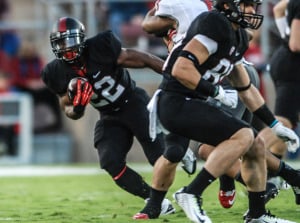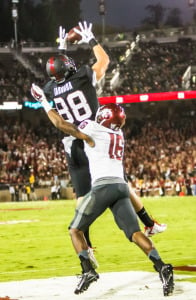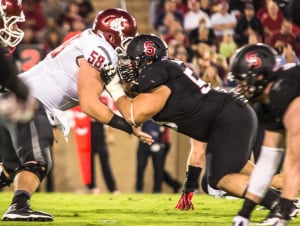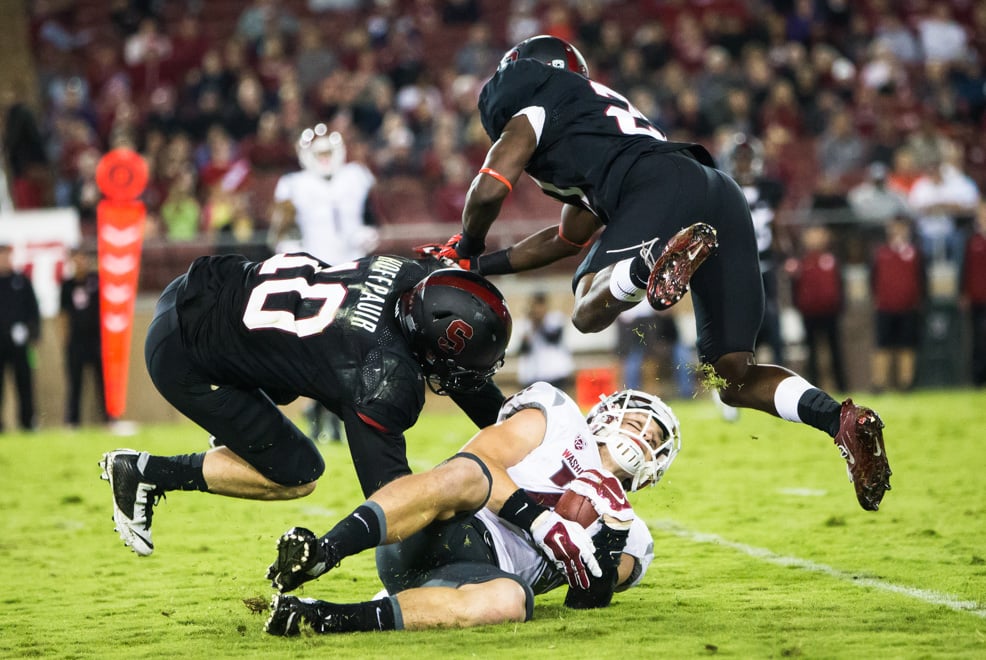In the midst of an unpredictable and frustrating season, there were two major questions for the Cardinal to answer on Friday night. Firstly, would the defense be able to hold back the floodgates of a Washington State air raid attack that had been experiencing unprecedented success? And more importantly, would Kevin Hogan and an inconsistent, frustrating offense be able to get back on track against a weak Cougar defense?
Well, consider both of those questions answered.
Just one week removed from putting up an unearthly 734 yards of passing in a tough loss to Cal, Connor Halliday and the Mike Leach air raid were brought convincingly down to terra firma, as a relentless Stanford defense limited the powerful Washington State offense to just 266 total yards. Meanwhile, Hogan had a sparkling day and the running game reestablished itself as the No. 25 Cardinal (4-2, 2-1 Pac-12) pulled away from the Cougars (2-5, 1-3) late in an important 34-17 win.
“Offensively, I thought tonight’s the first night that we looked like us and we felt like us,” said head coach David Shaw after the game.

Part of getting back that offensive mojo was getting the running game ticking again after the Cardinal ground attack was stuffed to the tune of just 47 yards against Notre Dame last week.
Junior Barry J. Sanders set a strong foundation for the game when he took control of the first drive and exploded for two big gains of 21 and 29 yards on his first two touches, surpassing the entire rush attack from the Notre Dame game within the first four plays from scrimmage.
And while the offensive line wasn’t perfect — the penalties were still there — the Cardinal front five did their jobs to open up holes for the backs to set the tone for a 193-yard rushing day in which Stanford averaged a very solid 5.8 yards per rush. Remound Wright led the charge with 14 touches for 99 yards, while Sanders added 68 and freshman Christian McCaffrey also contributed 28 on three touches as he broke into the starting running back rotation.
“I thought our offensive line was steady,” Shaw said. “We talked about not just trying to kill guys, we talked about just keeping them blocking, staying blocking and letting our runners be runners.”
The successful running game paved the way for Hogan to have one of his cleanest games in recent memory, as he looked truly comfortable in the pocket for the first time in several weeks and outdueled Halliday for most of the game.
Remember the days when Stanford was Tight End U after producing standout tight ends like Coby Fleener, Zach Ertz, Jim Dray and Levine Toilolo?
Friday’s passing game evoked memories of those days, as Cardinal tight ends combined for three touchdowns, including the first career
touchdown receptions of both Eric Cotton and Greg Taboada, for the first time since the 2011 game against Notre Dame. And with the awakening of the tight end slumber, the Cardinal red zone offense awoke as well.
“Coming into this week, we did put a little more red zone plays for the tight ends,” said Taboada, who caught an early touchdown on a fade before reeling in a short throw on a bootleg in the third quarter for another score. “So we put a couple more plays in and it worked out.”
Those were two of the three touchdowns that Hogan threw on Friday, with the third coming on a deep play-action ball down the middle for a 39-yard touchdown to Cotton in the first quarter to put the Cardinal up by 10 early. Hogan would finish 23-of-35 for 284 yards, three touchdowns and no picks — easily his best performance of the year from both a statistical and eye-test perspective.

While it looked early on as if the Cardinal’s red zone woes would continue after a Patrick Skov fumble at the 1-yard line, a missed Jordan Williamson field goal from 37 yards and consecutive holding penalties stalled drives, Stanford finished the day with scores on five of its seven red-zone trips, with three of its four touchdowns coming from inside the 20.
And for as much as the Cardinal offense pulled an about-face and righted the ship, the Stanford defense emphatically asserted its dominance as one of the best units in the nation.
Against a pass attack like that of Washington State that focuses on spraying the ball all over the field, it was critical for the Stanford defense to consistently get pressure on Halliday with only three or four rushers in order to maintain coverage on the Cougars’ numerous threats at wideout.
Enter David Parry.
The fifth-year senior nose tackle played one of the most sparkling games of his career, finishing the evening with a sack and a whopping five quarterback hurries, shrugging and plowing through blocks from an improved Washington State offensive line as if they weren’t even there.
“I think the difference was the physical nature of the Stanford players,” said Washington State head coach Mike Leach. “They’re bigger and stronger than we are.”
“That’s just a really good defensive front,” Halliday added. “Nothing our offensive line did wrong, they’re just a darn good front.”
Parry spearheaded a nasty pass rush that sacked Halliday four times and limited the Cougars to -26 net yards on the ground.
But regardless of how much pressure the defense would get on Halliday, he would still get most of his throws off to his talented receivers on the perimeter. And in that respect of the game, it was of utmost importance to have sound tackling and wrap-ups to limit yards after contact and big gains.
Enter Zach Hoffpauir.

The junior defensive back had the best game of his career, notching an eye-popping 15 tackles — a record among active Stanford players — while breaking up two passes playing nickel for most of the evening.
“I didn’t even realize how many [tackles] I had,” Hoffpauir said. “The ball kept coming to me and I ended up making the tackles and didn’t miss many. I missed a few and I can still get better, but it was cool.”
Hoffpauir was the key cog in a Stanford secondary that limited Halliday to just 292 yards passing — over 200 yards shy of his average of 509 yards per game coming into Friday’s matchup. While interceptions are hard to come by against a quick-throwing offense like that of the Cougars, senior inside linebacker Blake Martinez added a pick when Parry blew up his blockers and hit Halliday as he threw.
On the injury front, Stanford suffered two critical losses as both senior outside linebacker James Vaughters and senior wide receiver Devon Cajuste left the game with undisclosed injuries.
Moving ahead to next week, Stanford will have an extended week of practice for its players to get some rest as it prepares to head to Tempe, Arizona to take on another fast-paced offense and porous defense.
And in doing so, Shaw and the Cardinal will need to prepare to show the college football world that this game was the norm and not the anomaly as they move forward into the brunt of the Pac-12 schedule.
“We played hard, we played smart, guys made plays, and that’s what we need from our guys,” Shaw said. “That’s the biggest question to me. Can we get ourselves to play this way next week in Tempe and the week after that and the week after that? No matter when, no matter where.”
To view more of The Daily’s photographs from the game, please visit the photo gallery here.
Contact Do-Hyoung Park at dpark027 ‘at’ stanford.edu.
